Healthcare Ethics Case Study: Refusal of Treatment Analysis
VerifiedAdded on 2021/06/16
|8
|2109
|71
Case Study
AI Summary
This case study examines a scenario where a student, Amos, is denied medical treatment for cholera due to limited resources and non-residency status, leading to his death. The analysis focuses on ethical issues such as professional negligence, disinterested neglectfulness, and unprofessional conduct, highlighting violations of professional codes of conduct and ethical principles. It discusses the importance of patient rights, the responsibilities of healthcare providers, and the potential consequences of unethical behavior. The study emphasizes the importance of making informed decisions, providing patient-centered care, and adhering to ethical guidelines to prevent malpractice. The case study offers recommendations for improving professional practice, including the use of informed consent, prioritizing critical cases, and providing appropriate patient information and referrals, ultimately stressing the need for healthcare providers to act ethically and competently.
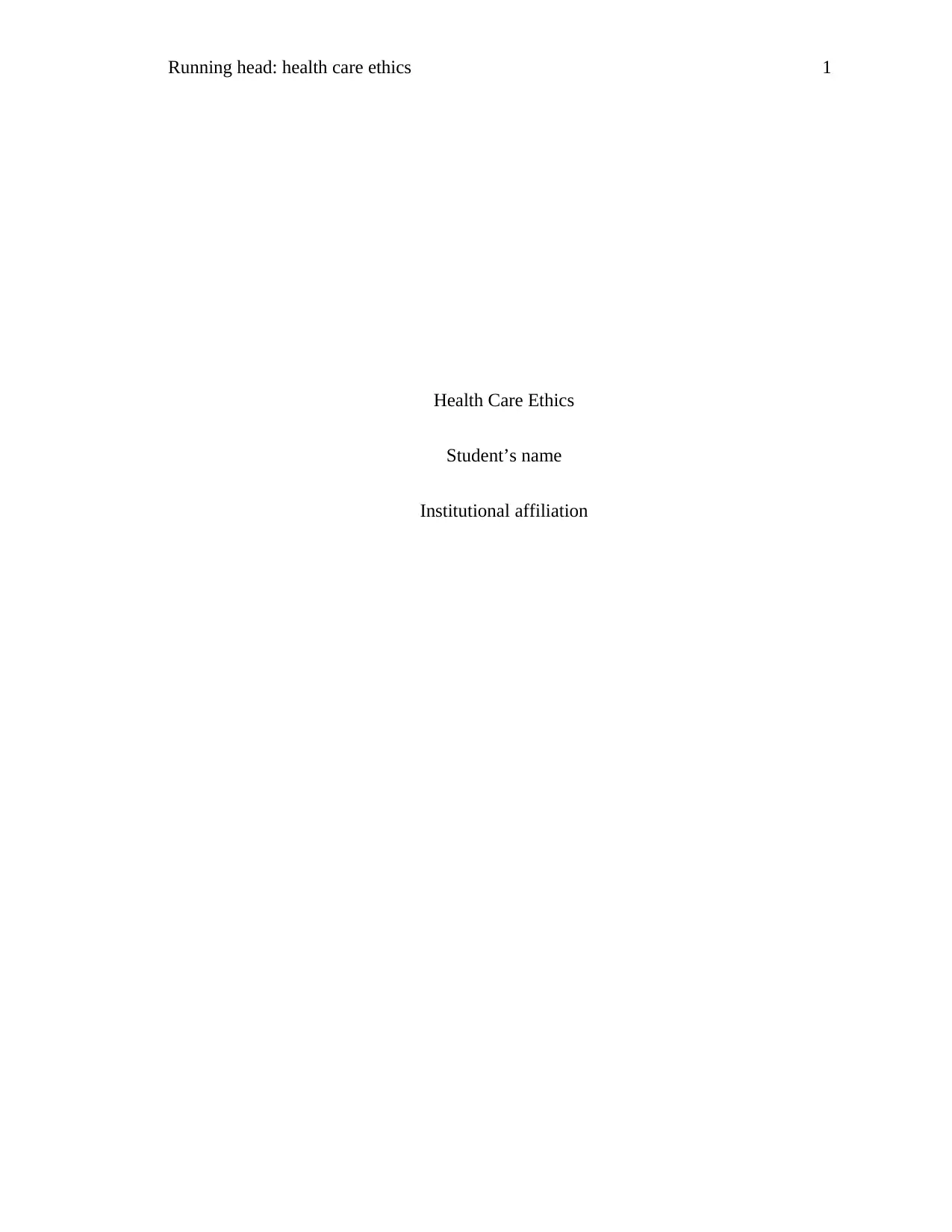
Running head: health care ethics 1
Health Care Ethics
Student’s name
Institutional affiliation
Health Care Ethics
Student’s name
Institutional affiliation
Paraphrase This Document
Need a fresh take? Get an instant paraphrase of this document with our AI Paraphraser
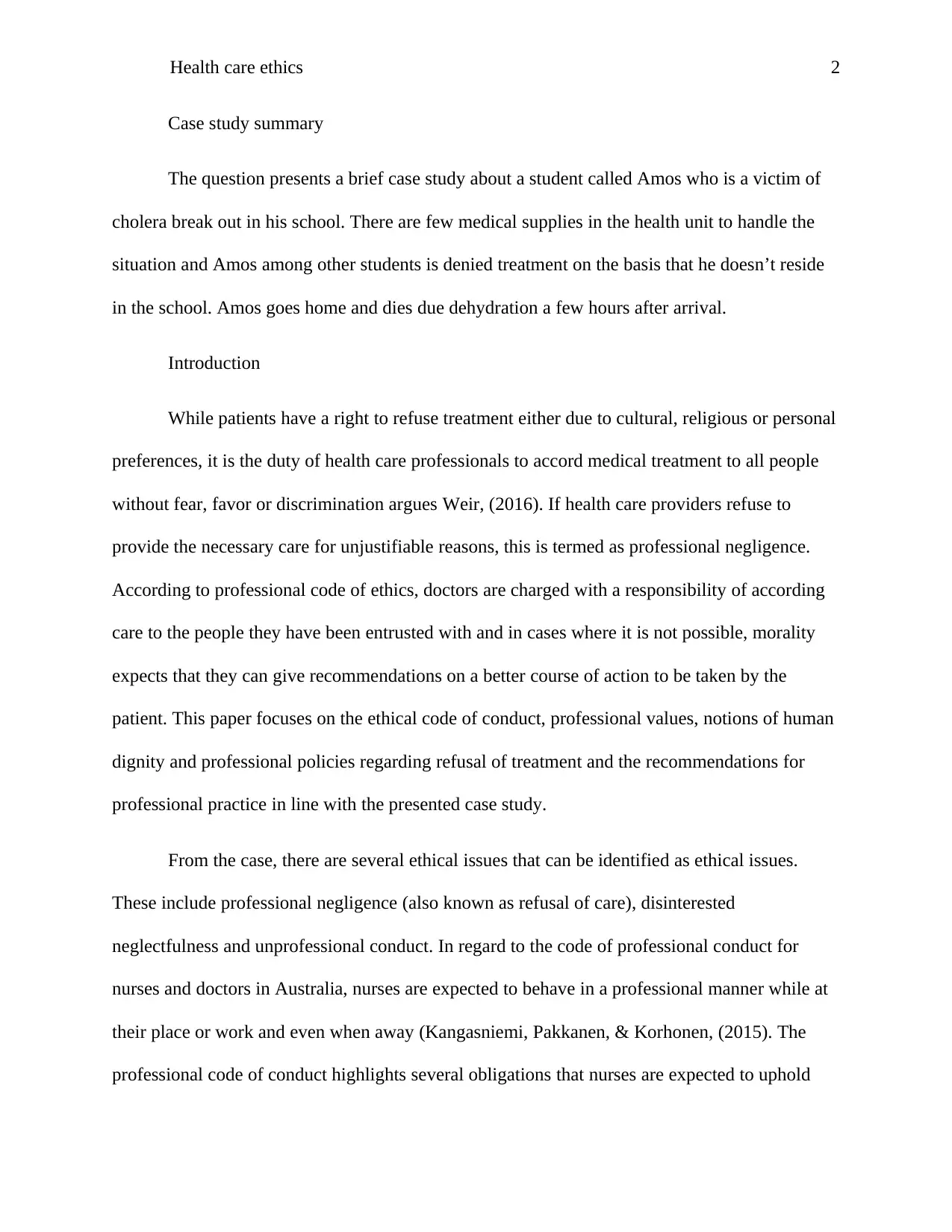
Health care ethics 2
Case study summary
The question presents a brief case study about a student called Amos who is a victim of
cholera break out in his school. There are few medical supplies in the health unit to handle the
situation and Amos among other students is denied treatment on the basis that he doesn’t reside
in the school. Amos goes home and dies due dehydration a few hours after arrival.
Introduction
While patients have a right to refuse treatment either due to cultural, religious or personal
preferences, it is the duty of health care professionals to accord medical treatment to all people
without fear, favor or discrimination argues Weir, (2016). If health care providers refuse to
provide the necessary care for unjustifiable reasons, this is termed as professional negligence.
According to professional code of ethics, doctors are charged with a responsibility of according
care to the people they have been entrusted with and in cases where it is not possible, morality
expects that they can give recommendations on a better course of action to be taken by the
patient. This paper focuses on the ethical code of conduct, professional values, notions of human
dignity and professional policies regarding refusal of treatment and the recommendations for
professional practice in line with the presented case study.
From the case, there are several ethical issues that can be identified as ethical issues.
These include professional negligence (also known as refusal of care), disinterested
neglectfulness and unprofessional conduct. In regard to the code of professional conduct for
nurses and doctors in Australia, nurses are expected to behave in a professional manner while at
their place or work and even when away (Kangasniemi, Pakkanen, & Korhonen, (2015). The
professional code of conduct highlights several obligations that nurses are expected to uphold
Case study summary
The question presents a brief case study about a student called Amos who is a victim of
cholera break out in his school. There are few medical supplies in the health unit to handle the
situation and Amos among other students is denied treatment on the basis that he doesn’t reside
in the school. Amos goes home and dies due dehydration a few hours after arrival.
Introduction
While patients have a right to refuse treatment either due to cultural, religious or personal
preferences, it is the duty of health care professionals to accord medical treatment to all people
without fear, favor or discrimination argues Weir, (2016). If health care providers refuse to
provide the necessary care for unjustifiable reasons, this is termed as professional negligence.
According to professional code of ethics, doctors are charged with a responsibility of according
care to the people they have been entrusted with and in cases where it is not possible, morality
expects that they can give recommendations on a better course of action to be taken by the
patient. This paper focuses on the ethical code of conduct, professional values, notions of human
dignity and professional policies regarding refusal of treatment and the recommendations for
professional practice in line with the presented case study.
From the case, there are several ethical issues that can be identified as ethical issues.
These include professional negligence (also known as refusal of care), disinterested
neglectfulness and unprofessional conduct. In regard to the code of professional conduct for
nurses and doctors in Australia, nurses are expected to behave in a professional manner while at
their place or work and even when away (Kangasniemi, Pakkanen, & Korhonen, (2015). The
professional code of conduct highlights several obligations that nurses are expected to uphold
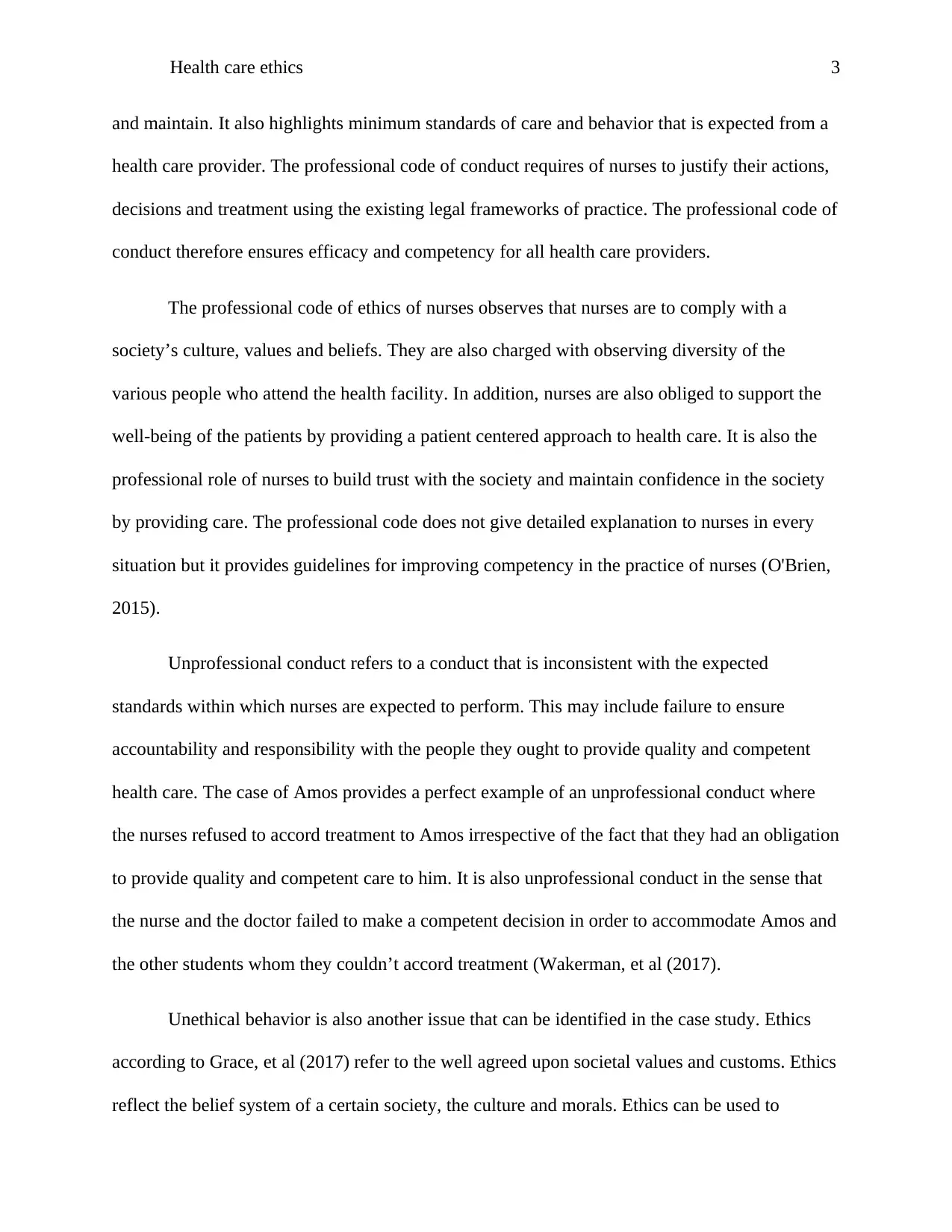
Health care ethics 3
and maintain. It also highlights minimum standards of care and behavior that is expected from a
health care provider. The professional code of conduct requires of nurses to justify their actions,
decisions and treatment using the existing legal frameworks of practice. The professional code of
conduct therefore ensures efficacy and competency for all health care providers.
The professional code of ethics of nurses observes that nurses are to comply with a
society’s culture, values and beliefs. They are also charged with observing diversity of the
various people who attend the health facility. In addition, nurses are also obliged to support the
well-being of the patients by providing a patient centered approach to health care. It is also the
professional role of nurses to build trust with the society and maintain confidence in the society
by providing care. The professional code does not give detailed explanation to nurses in every
situation but it provides guidelines for improving competency in the practice of nurses (O'Brien,
2015).
Unprofessional conduct refers to a conduct that is inconsistent with the expected
standards within which nurses are expected to perform. This may include failure to ensure
accountability and responsibility with the people they ought to provide quality and competent
health care. The case of Amos provides a perfect example of an unprofessional conduct where
the nurses refused to accord treatment to Amos irrespective of the fact that they had an obligation
to provide quality and competent care to him. It is also unprofessional conduct in the sense that
the nurse and the doctor failed to make a competent decision in order to accommodate Amos and
the other students whom they couldn’t accord treatment (Wakerman, et al (2017).
Unethical behavior is also another issue that can be identified in the case study. Ethics
according to Grace, et al (2017) refer to the well agreed upon societal values and customs. Ethics
reflect the belief system of a certain society, the culture and morals. Ethics can be used to
and maintain. It also highlights minimum standards of care and behavior that is expected from a
health care provider. The professional code of conduct requires of nurses to justify their actions,
decisions and treatment using the existing legal frameworks of practice. The professional code of
conduct therefore ensures efficacy and competency for all health care providers.
The professional code of ethics of nurses observes that nurses are to comply with a
society’s culture, values and beliefs. They are also charged with observing diversity of the
various people who attend the health facility. In addition, nurses are also obliged to support the
well-being of the patients by providing a patient centered approach to health care. It is also the
professional role of nurses to build trust with the society and maintain confidence in the society
by providing care. The professional code does not give detailed explanation to nurses in every
situation but it provides guidelines for improving competency in the practice of nurses (O'Brien,
2015).
Unprofessional conduct refers to a conduct that is inconsistent with the expected
standards within which nurses are expected to perform. This may include failure to ensure
accountability and responsibility with the people they ought to provide quality and competent
health care. The case of Amos provides a perfect example of an unprofessional conduct where
the nurses refused to accord treatment to Amos irrespective of the fact that they had an obligation
to provide quality and competent care to him. It is also unprofessional conduct in the sense that
the nurse and the doctor failed to make a competent decision in order to accommodate Amos and
the other students whom they couldn’t accord treatment (Wakerman, et al (2017).
Unethical behavior is also another issue that can be identified in the case study. Ethics
according to Grace, et al (2017) refer to the well agreed upon societal values and customs. Ethics
reflect the belief system of a certain society, the culture and morals. Ethics can be used to
⊘ This is a preview!⊘
Do you want full access?
Subscribe today to unlock all pages.

Trusted by 1+ million students worldwide
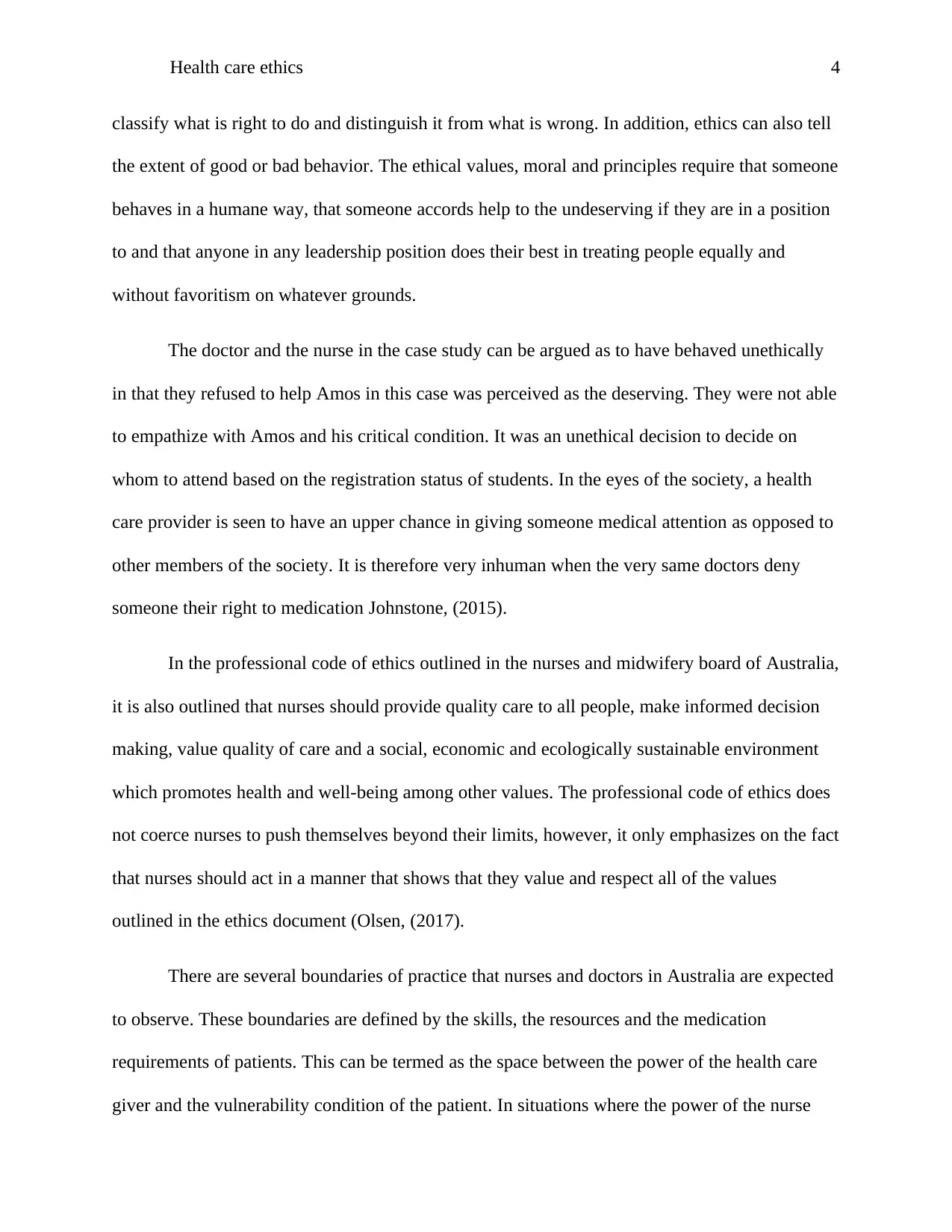
Health care ethics 4
classify what is right to do and distinguish it from what is wrong. In addition, ethics can also tell
the extent of good or bad behavior. The ethical values, moral and principles require that someone
behaves in a humane way, that someone accords help to the undeserving if they are in a position
to and that anyone in any leadership position does their best in treating people equally and
without favoritism on whatever grounds.
The doctor and the nurse in the case study can be argued as to have behaved unethically
in that they refused to help Amos in this case was perceived as the deserving. They were not able
to empathize with Amos and his critical condition. It was an unethical decision to decide on
whom to attend based on the registration status of students. In the eyes of the society, a health
care provider is seen to have an upper chance in giving someone medical attention as opposed to
other members of the society. It is therefore very inhuman when the very same doctors deny
someone their right to medication Johnstone, (2015).
In the professional code of ethics outlined in the nurses and midwifery board of Australia,
it is also outlined that nurses should provide quality care to all people, make informed decision
making, value quality of care and a social, economic and ecologically sustainable environment
which promotes health and well-being among other values. The professional code of ethics does
not coerce nurses to push themselves beyond their limits, however, it only emphasizes on the fact
that nurses should act in a manner that shows that they value and respect all of the values
outlined in the ethics document (Olsen, (2017).
There are several boundaries of practice that nurses and doctors in Australia are expected
to observe. These boundaries are defined by the skills, the resources and the medication
requirements of patients. This can be termed as the space between the power of the health care
giver and the vulnerability condition of the patient. In situations where the power of the nurse
classify what is right to do and distinguish it from what is wrong. In addition, ethics can also tell
the extent of good or bad behavior. The ethical values, moral and principles require that someone
behaves in a humane way, that someone accords help to the undeserving if they are in a position
to and that anyone in any leadership position does their best in treating people equally and
without favoritism on whatever grounds.
The doctor and the nurse in the case study can be argued as to have behaved unethically
in that they refused to help Amos in this case was perceived as the deserving. They were not able
to empathize with Amos and his critical condition. It was an unethical decision to decide on
whom to attend based on the registration status of students. In the eyes of the society, a health
care provider is seen to have an upper chance in giving someone medical attention as opposed to
other members of the society. It is therefore very inhuman when the very same doctors deny
someone their right to medication Johnstone, (2015).
In the professional code of ethics outlined in the nurses and midwifery board of Australia,
it is also outlined that nurses should provide quality care to all people, make informed decision
making, value quality of care and a social, economic and ecologically sustainable environment
which promotes health and well-being among other values. The professional code of ethics does
not coerce nurses to push themselves beyond their limits, however, it only emphasizes on the fact
that nurses should act in a manner that shows that they value and respect all of the values
outlined in the ethics document (Olsen, (2017).
There are several boundaries of practice that nurses and doctors in Australia are expected
to observe. These boundaries are defined by the skills, the resources and the medication
requirements of patients. This can be termed as the space between the power of the health care
giver and the vulnerability condition of the patient. In situations where the power of the nurse
Paraphrase This Document
Need a fresh take? Get an instant paraphrase of this document with our AI Paraphraser
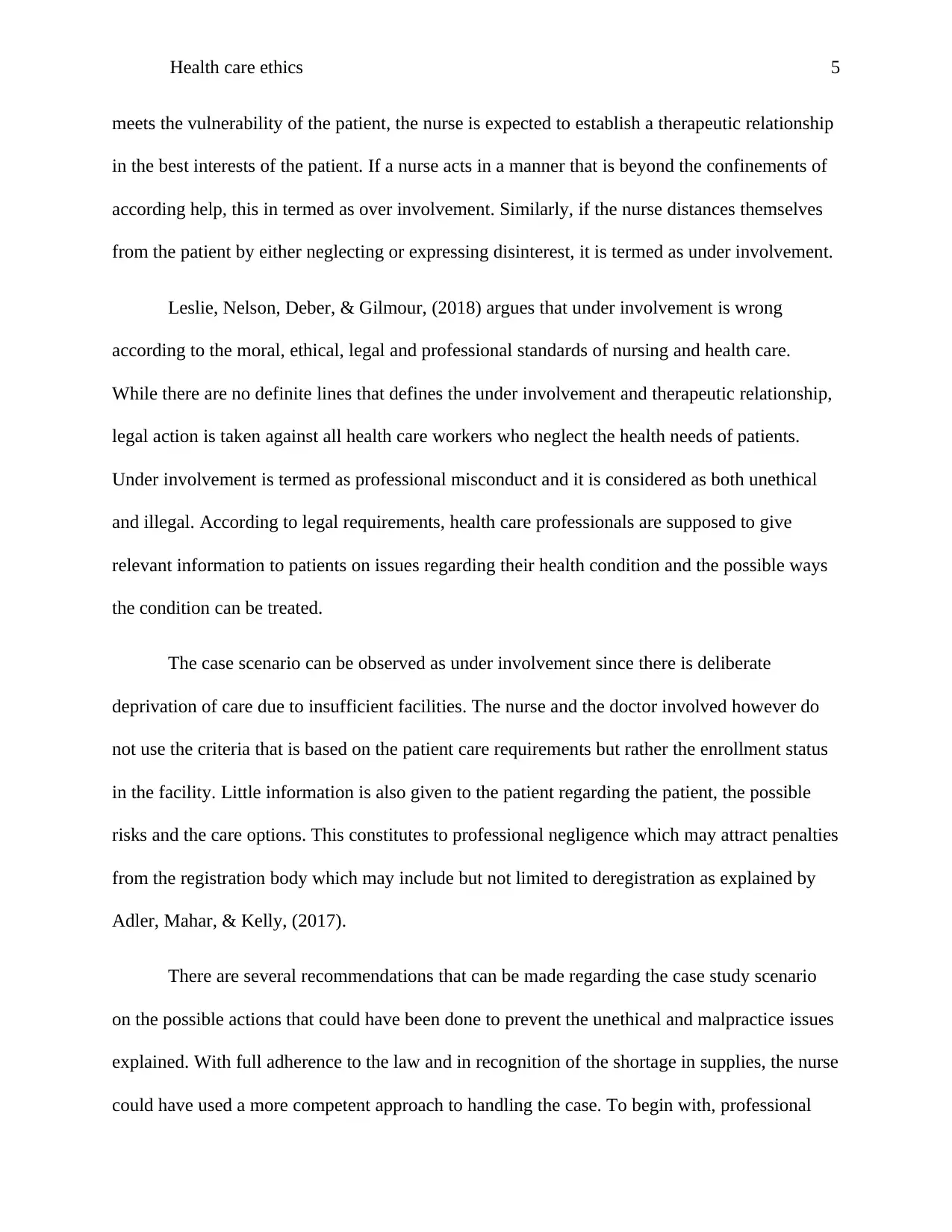
Health care ethics 5
meets the vulnerability of the patient, the nurse is expected to establish a therapeutic relationship
in the best interests of the patient. If a nurse acts in a manner that is beyond the confinements of
according help, this in termed as over involvement. Similarly, if the nurse distances themselves
from the patient by either neglecting or expressing disinterest, it is termed as under involvement.
Leslie, Nelson, Deber, & Gilmour, (2018) argues that under involvement is wrong
according to the moral, ethical, legal and professional standards of nursing and health care.
While there are no definite lines that defines the under involvement and therapeutic relationship,
legal action is taken against all health care workers who neglect the health needs of patients.
Under involvement is termed as professional misconduct and it is considered as both unethical
and illegal. According to legal requirements, health care professionals are supposed to give
relevant information to patients on issues regarding their health condition and the possible ways
the condition can be treated.
The case scenario can be observed as under involvement since there is deliberate
deprivation of care due to insufficient facilities. The nurse and the doctor involved however do
not use the criteria that is based on the patient care requirements but rather the enrollment status
in the facility. Little information is also given to the patient regarding the patient, the possible
risks and the care options. This constitutes to professional negligence which may attract penalties
from the registration body which may include but not limited to deregistration as explained by
Adler, Mahar, & Kelly, (2017).
There are several recommendations that can be made regarding the case study scenario
on the possible actions that could have been done to prevent the unethical and malpractice issues
explained. With full adherence to the law and in recognition of the shortage in supplies, the nurse
could have used a more competent approach to handling the case. To begin with, professional
meets the vulnerability of the patient, the nurse is expected to establish a therapeutic relationship
in the best interests of the patient. If a nurse acts in a manner that is beyond the confinements of
according help, this in termed as over involvement. Similarly, if the nurse distances themselves
from the patient by either neglecting or expressing disinterest, it is termed as under involvement.
Leslie, Nelson, Deber, & Gilmour, (2018) argues that under involvement is wrong
according to the moral, ethical, legal and professional standards of nursing and health care.
While there are no definite lines that defines the under involvement and therapeutic relationship,
legal action is taken against all health care workers who neglect the health needs of patients.
Under involvement is termed as professional misconduct and it is considered as both unethical
and illegal. According to legal requirements, health care professionals are supposed to give
relevant information to patients on issues regarding their health condition and the possible ways
the condition can be treated.
The case scenario can be observed as under involvement since there is deliberate
deprivation of care due to insufficient facilities. The nurse and the doctor involved however do
not use the criteria that is based on the patient care requirements but rather the enrollment status
in the facility. Little information is also given to the patient regarding the patient, the possible
risks and the care options. This constitutes to professional negligence which may attract penalties
from the registration body which may include but not limited to deregistration as explained by
Adler, Mahar, & Kelly, (2017).
There are several recommendations that can be made regarding the case study scenario
on the possible actions that could have been done to prevent the unethical and malpractice issues
explained. With full adherence to the law and in recognition of the shortage in supplies, the nurse
could have used a more competent approach to handling the case. To begin with, professional
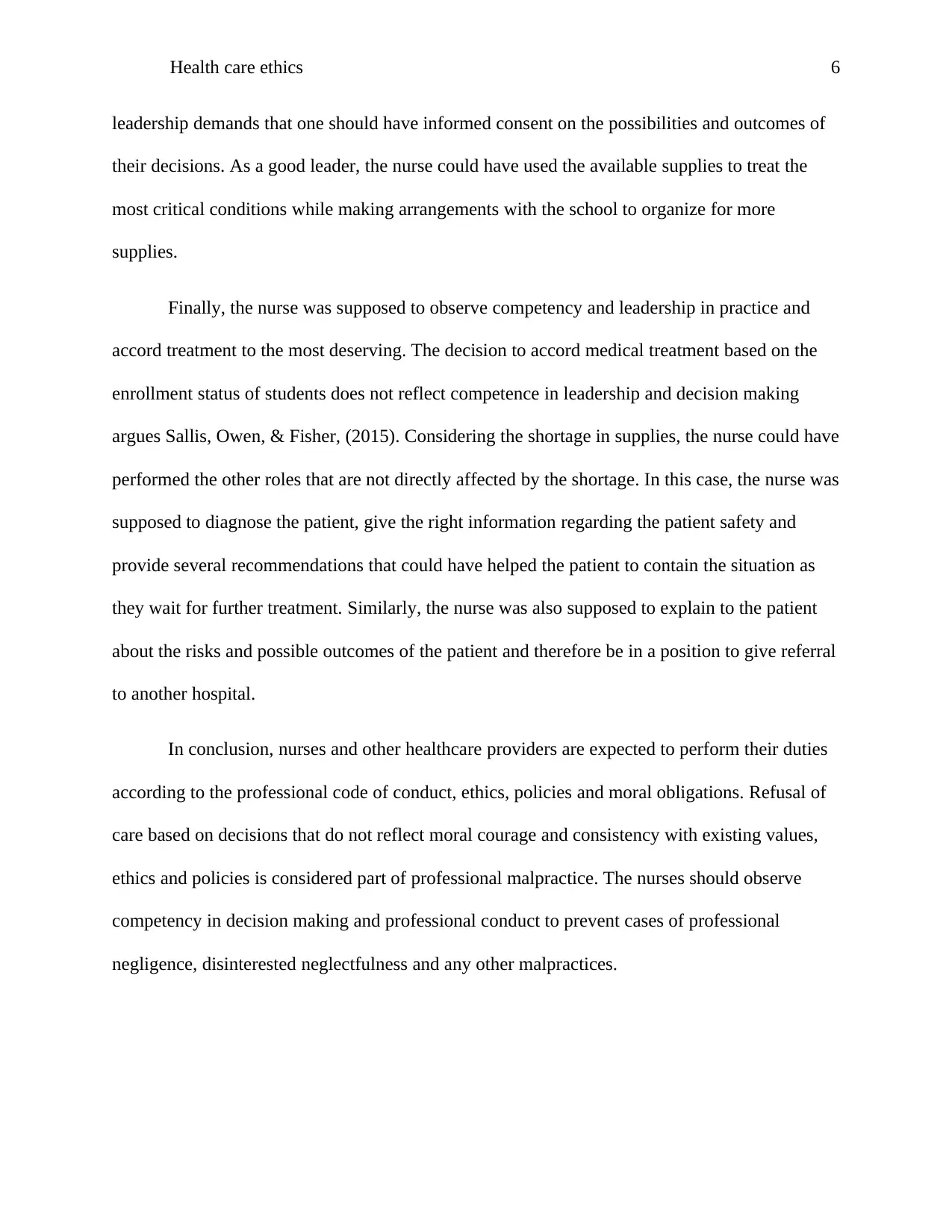
Health care ethics 6
leadership demands that one should have informed consent on the possibilities and outcomes of
their decisions. As a good leader, the nurse could have used the available supplies to treat the
most critical conditions while making arrangements with the school to organize for more
supplies.
Finally, the nurse was supposed to observe competency and leadership in practice and
accord treatment to the most deserving. The decision to accord medical treatment based on the
enrollment status of students does not reflect competence in leadership and decision making
argues Sallis, Owen, & Fisher, (2015). Considering the shortage in supplies, the nurse could have
performed the other roles that are not directly affected by the shortage. In this case, the nurse was
supposed to diagnose the patient, give the right information regarding the patient safety and
provide several recommendations that could have helped the patient to contain the situation as
they wait for further treatment. Similarly, the nurse was also supposed to explain to the patient
about the risks and possible outcomes of the patient and therefore be in a position to give referral
to another hospital.
In conclusion, nurses and other healthcare providers are expected to perform their duties
according to the professional code of conduct, ethics, policies and moral obligations. Refusal of
care based on decisions that do not reflect moral courage and consistency with existing values,
ethics and policies is considered part of professional malpractice. The nurses should observe
competency in decision making and professional conduct to prevent cases of professional
negligence, disinterested neglectfulness and any other malpractices.
leadership demands that one should have informed consent on the possibilities and outcomes of
their decisions. As a good leader, the nurse could have used the available supplies to treat the
most critical conditions while making arrangements with the school to organize for more
supplies.
Finally, the nurse was supposed to observe competency and leadership in practice and
accord treatment to the most deserving. The decision to accord medical treatment based on the
enrollment status of students does not reflect competence in leadership and decision making
argues Sallis, Owen, & Fisher, (2015). Considering the shortage in supplies, the nurse could have
performed the other roles that are not directly affected by the shortage. In this case, the nurse was
supposed to diagnose the patient, give the right information regarding the patient safety and
provide several recommendations that could have helped the patient to contain the situation as
they wait for further treatment. Similarly, the nurse was also supposed to explain to the patient
about the risks and possible outcomes of the patient and therefore be in a position to give referral
to another hospital.
In conclusion, nurses and other healthcare providers are expected to perform their duties
according to the professional code of conduct, ethics, policies and moral obligations. Refusal of
care based on decisions that do not reflect moral courage and consistency with existing values,
ethics and policies is considered part of professional malpractice. The nurses should observe
competency in decision making and professional conduct to prevent cases of professional
negligence, disinterested neglectfulness and any other malpractices.
⊘ This is a preview!⊘
Do you want full access?
Subscribe today to unlock all pages.

Trusted by 1+ million students worldwide
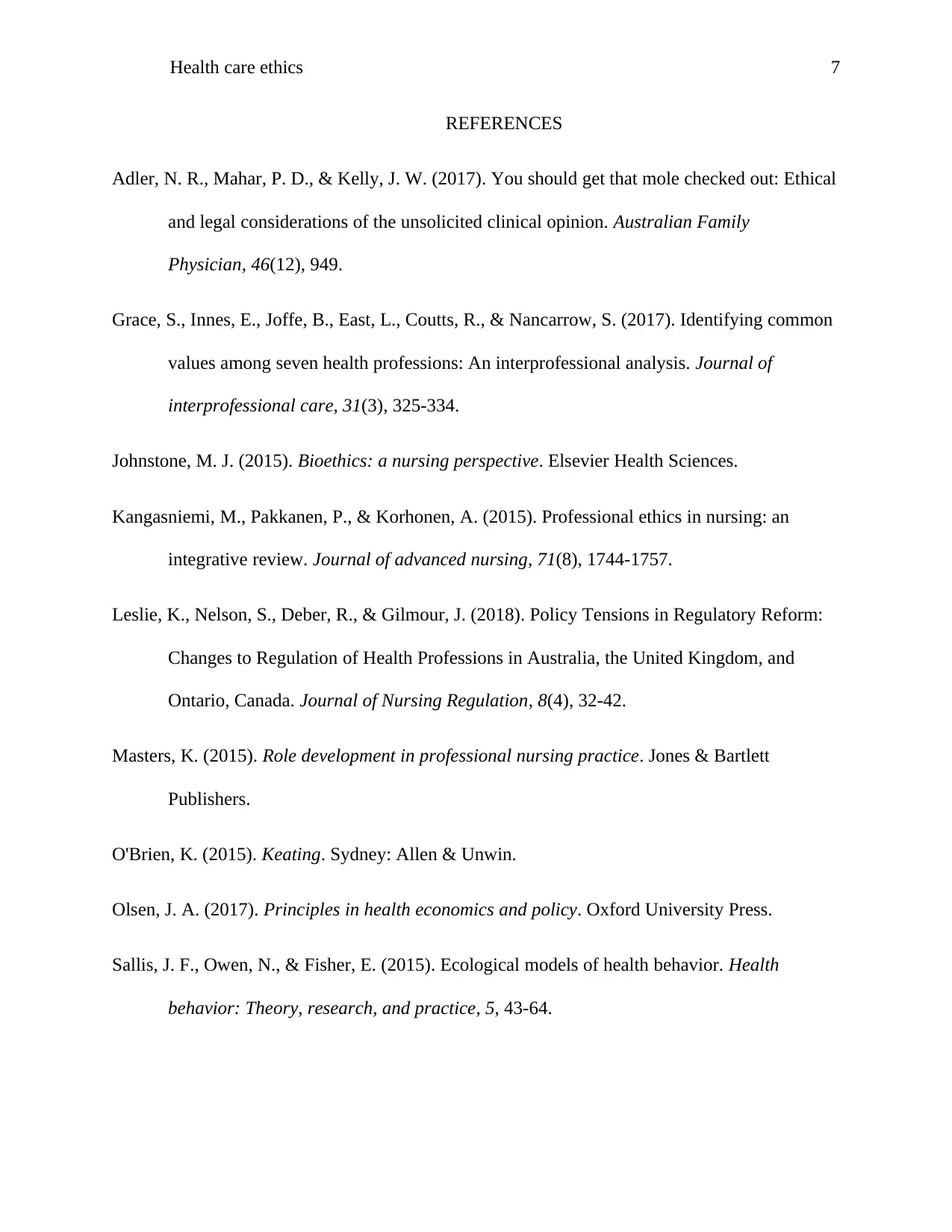
Health care ethics 7
REFERENCES
Adler, N. R., Mahar, P. D., & Kelly, J. W. (2017). You should get that mole checked out: Ethical
and legal considerations of the unsolicited clinical opinion. Australian Family
Physician, 46(12), 949.
Grace, S., Innes, E., Joffe, B., East, L., Coutts, R., & Nancarrow, S. (2017). Identifying common
values among seven health professions: An interprofessional analysis. Journal of
interprofessional care, 31(3), 325-334.
Johnstone, M. J. (2015). Bioethics: a nursing perspective. Elsevier Health Sciences.
Kangasniemi, M., Pakkanen, P., & Korhonen, A. (2015). Professional ethics in nursing: an
integrative review. Journal of advanced nursing, 71(8), 1744-1757.
Leslie, K., Nelson, S., Deber, R., & Gilmour, J. (2018). Policy Tensions in Regulatory Reform:
Changes to Regulation of Health Professions in Australia, the United Kingdom, and
Ontario, Canada. Journal of Nursing Regulation, 8(4), 32-42.
Masters, K. (2015). Role development in professional nursing practice. Jones & Bartlett
Publishers.
O'Brien, K. (2015). Keating. Sydney: Allen & Unwin.
Olsen, J. A. (2017). Principles in health economics and policy. Oxford University Press.
Sallis, J. F., Owen, N., & Fisher, E. (2015). Ecological models of health behavior. Health
behavior: Theory, research, and practice, 5, 43-64.
REFERENCES
Adler, N. R., Mahar, P. D., & Kelly, J. W. (2017). You should get that mole checked out: Ethical
and legal considerations of the unsolicited clinical opinion. Australian Family
Physician, 46(12), 949.
Grace, S., Innes, E., Joffe, B., East, L., Coutts, R., & Nancarrow, S. (2017). Identifying common
values among seven health professions: An interprofessional analysis. Journal of
interprofessional care, 31(3), 325-334.
Johnstone, M. J. (2015). Bioethics: a nursing perspective. Elsevier Health Sciences.
Kangasniemi, M., Pakkanen, P., & Korhonen, A. (2015). Professional ethics in nursing: an
integrative review. Journal of advanced nursing, 71(8), 1744-1757.
Leslie, K., Nelson, S., Deber, R., & Gilmour, J. (2018). Policy Tensions in Regulatory Reform:
Changes to Regulation of Health Professions in Australia, the United Kingdom, and
Ontario, Canada. Journal of Nursing Regulation, 8(4), 32-42.
Masters, K. (2015). Role development in professional nursing practice. Jones & Bartlett
Publishers.
O'Brien, K. (2015). Keating. Sydney: Allen & Unwin.
Olsen, J. A. (2017). Principles in health economics and policy. Oxford University Press.
Sallis, J. F., Owen, N., & Fisher, E. (2015). Ecological models of health behavior. Health
behavior: Theory, research, and practice, 5, 43-64.
Paraphrase This Document
Need a fresh take? Get an instant paraphrase of this document with our AI Paraphraser
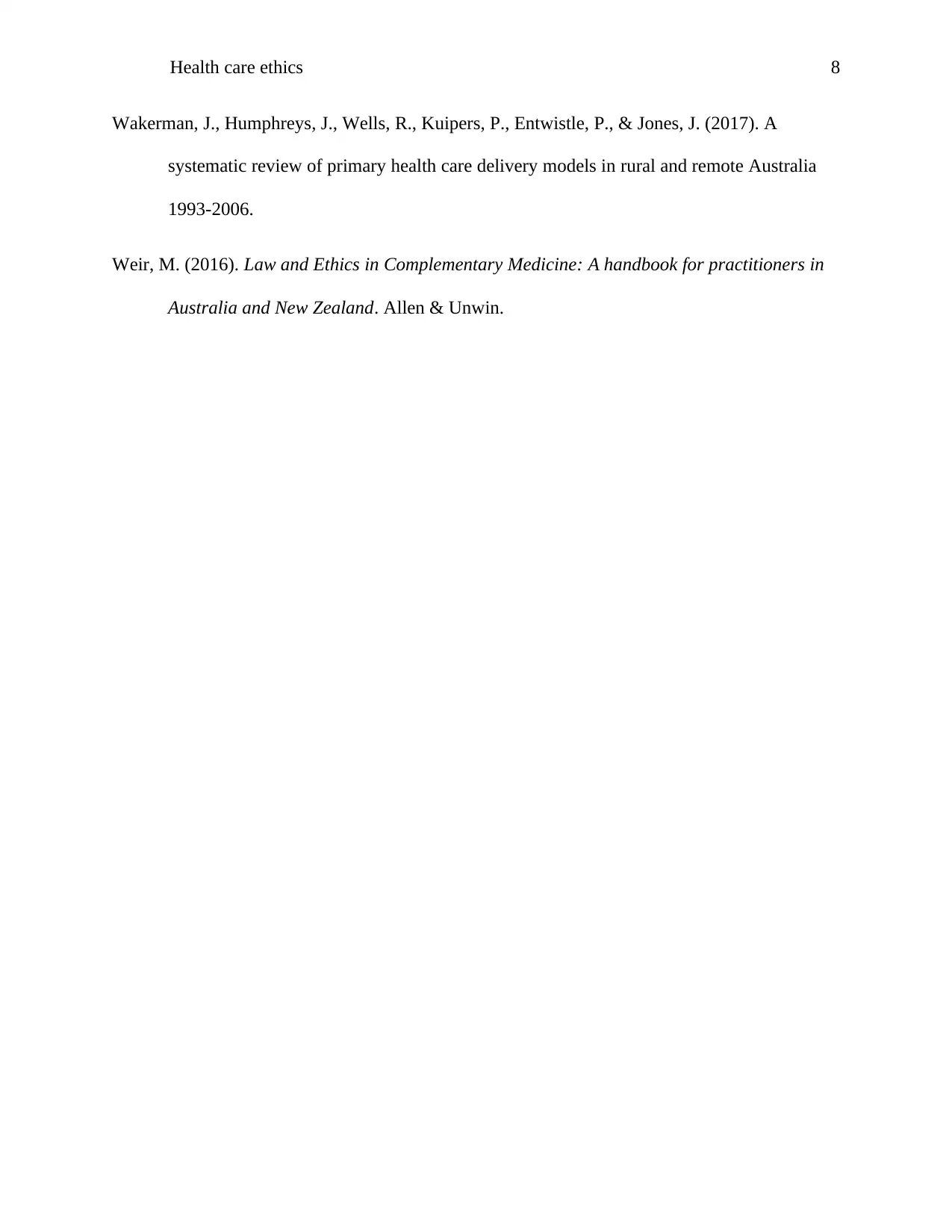
Health care ethics 8
Wakerman, J., Humphreys, J., Wells, R., Kuipers, P., Entwistle, P., & Jones, J. (2017). A
systematic review of primary health care delivery models in rural and remote Australia
1993-2006.
Weir, M. (2016). Law and Ethics in Complementary Medicine: A handbook for practitioners in
Australia and New Zealand. Allen & Unwin.
Wakerman, J., Humphreys, J., Wells, R., Kuipers, P., Entwistle, P., & Jones, J. (2017). A
systematic review of primary health care delivery models in rural and remote Australia
1993-2006.
Weir, M. (2016). Law and Ethics in Complementary Medicine: A handbook for practitioners in
Australia and New Zealand. Allen & Unwin.
1 out of 8
Related Documents
Your All-in-One AI-Powered Toolkit for Academic Success.
+13062052269
info@desklib.com
Available 24*7 on WhatsApp / Email
![[object Object]](/_next/static/media/star-bottom.7253800d.svg)
Unlock your academic potential
Copyright © 2020–2025 A2Z Services. All Rights Reserved. Developed and managed by ZUCOL.




